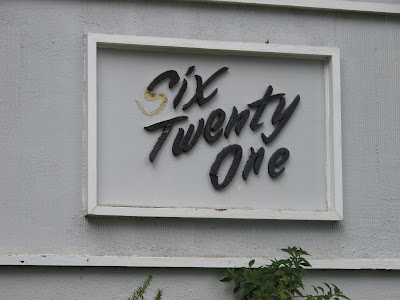 These were the sorts of building that were supposed to be "starter-places" for your arrival here in the City of Angels ... of course we know the real story. Sometimes they were the only chapter -- before one hightailed it out of town.
These were the sorts of building that were supposed to be "starter-places" for your arrival here in the City of Angels ... of course we know the real story. Sometimes they were the only chapter -- before one hightailed it out of town.They are known as "dingbats" We see rows and rows and rows of them all over the city proper and the bedroom communities adjacent to it -- particularly the Valley, the South Bay and Pasadena.
Here's a snip from a piece called "Dingbat Living."
"... I am less intrigued with the builders of the dingbats than with the people who eventually moved into these beauties. These were the people who truly made Los Angeles what it is today — the recent transplants, the surfers, the starving actors, the people who were willing to suffer their surroundings because they felt they were destined for something better, something that only Los Angeles could offer."
They are all over, so ubiquitous that you probably don't even quite notice them. However, when I returned from living in the Bay Area I realized how prevalent -- and unique -- that they were -- and began to pay more attention to what they meant to L.A. and how they had come to define our environment.
As Reyner Banham wrote in his seminal work on the architecture of the Southland, "Los Angeles: The Architecture of Four Ecologies, the dingbat "is the true symptom of Los Angeles' urban Id ."
Writer Gary Indiana goes several steps further, calling the dingbat, "A bad idea run amok, these one- or two- (sometimes three-) story stucco shoeboxes that nearly everyone lives in at one time or another in L.A. have an existential emptiness that can be gussied up and dissembled by track lighting nd the right sort of throw pillows and furniture but the spatial insipidity of the dingbat eventually defeats most efforts to turn a 'unit' into 'home,' even when little enliven the façade."
During and after college, friends of mine would find their way into one of these, and, as Indiana suggests, try to brighten them up with plants and throw pillows and beads and "mood lighting."
Nothing doing. But it was home and it was "transitional" and often the first articulation of "self-hood" so in many ways it is an important part of the life in L.A. narrative -- trying to define (and individualize) yourself within the busy sprawl of an anonymous place.
 |
| "Desiree" |
 |
| "breezeway w/ pool" |
 |
| "Terrace" |
 |
| Here at least, a little truth in advertising. simply put. |


i wonder if anyone has done a definitive study on the trends in these names. many of LA's early 20th century residents came from across the country and would have been used to brownstones and other buildings named after benefactors and builders and locations (the "so and so arms" or "the huntington"), and of course the claiming of the mexican heritage (el marino, las palmas, etc), but after world war two there came the influence of the south pacific and the ploynesian themes (the mona kai, etc).
ReplyDeleteis the naming just a way to prevent "the boxy green building along the row of boxy apartments" sort of description, a reinvention of an apartment the way wannabe stars change their names? "i may be simple studio apartments, but you can call me the rapa nui and live with that glimmer of the exotic, if only in your heart."
also, i wonder about the influence of disneyland and the idea of everything having a "theme." selling something more than just a functional space, selling a secret hope or aspiration in a land that can be hard on people's hopes and aspirations.
that's a good point -- the theme idea -- these apartment building became popular in the 50s and 60s and were fungible in certain respects - in that the interiors could be configured into something "personal" (except the cottage cheese ceilings...but some people did hang nautical netting, as we know) ... and yes, i think the exotic was a way to make people not feel so glum about the L.A. compromise they just made . . . .
ReplyDeletethanks for your comment